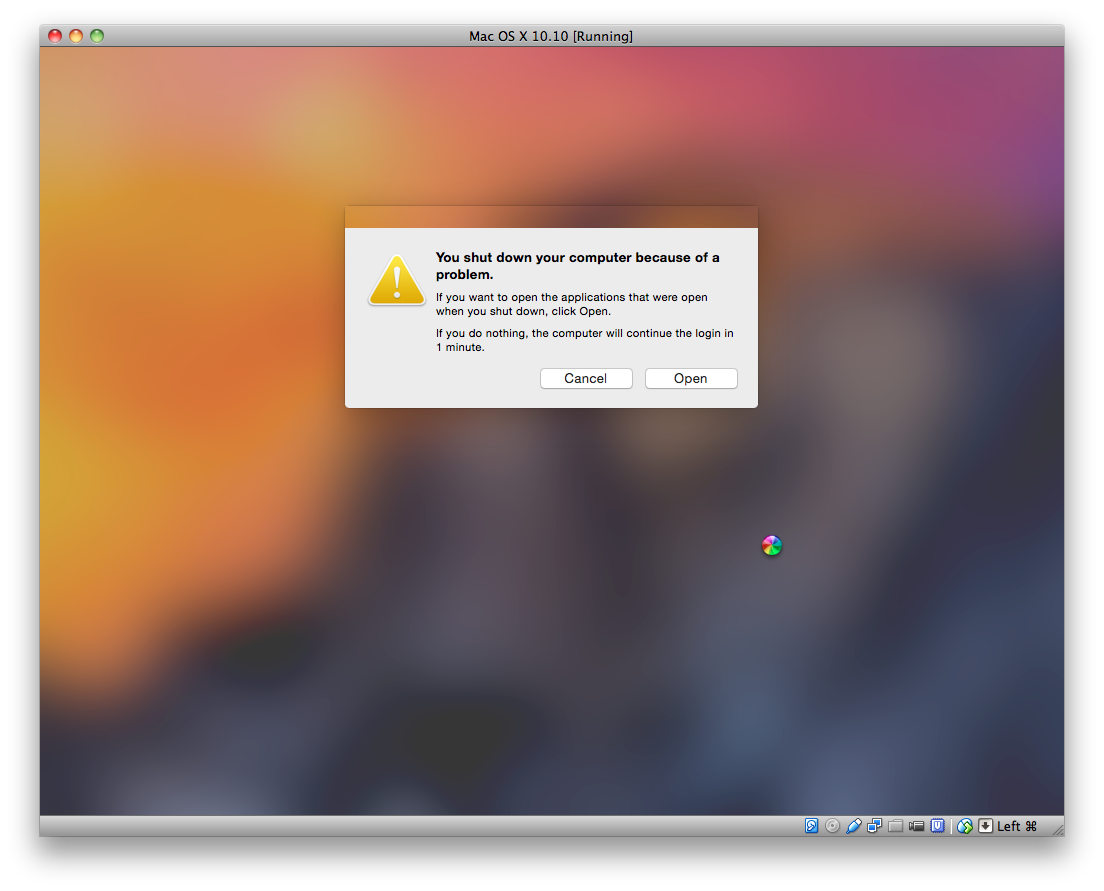

- VIRTUALBOX MAC OS X YOSEMITE HOW TO
- VIRTUALBOX MAC OS X YOSEMITE INSTALL
- VIRTUALBOX MAC OS X YOSEMITE WINDOWS
Execute and make sure the modules loads successfully. These can be found in out/darwin.x86/release/dist along with a small script ( loadall.sh) to load them.

This step only has to be done once (if something changes in your build tool setup, you might have to repeat it but keep in mind that both output files will be overwritten). Also, it will create an environment setup script called env.sh. If it finds everything it needs, it will create a file called !AutoConfig.kmk containing paths to the various tools on your system. You can manually set the target architecture with -target-arch=x86 or amd64, if some architecture related problems occur. Change to the root directory of the sources and execute the configure script:.If you are running 10.10 (Yosemite) there is a boot-args option for allowing the loading of unsigned kexts. Loading self-built kernel extensions (kexts) on more recent OS X may require changes to the system config unless you have a kext signing certificate and is running 10.14 (High Sierra) or earlier.įor 10.11 (El Capitan) and later boot to the recovery partition and either enabling loading of unsigned kexts:įor 10.15 (Catalina) and later you also need to disable the reboot requirement (also from recovery partition):.
VIRTUALBOX MAC OS X YOSEMITE INSTALL
Sudo port install libidl acpica yasm subversion doxygen texlive texlive-latex-extra texlive-fonts-extra x86_64-elf-gccĭoxygen, texlive* and x86_64-elf-gcc are optional (first two for documentation, latter for the validation kit). Until recently the official builds were done using Xcode 6.2 (you may use the tools/darwin.amd64/bin/ script to 'install' the necessary bits on later OS X versions).Īfter installing MacPorts, do not forget to make sure the following two lines are in your ~/.profile or ~/.zprofile file and actually loaded in the shell you're using:Įxport PATH=/opt/local/bin:/opt/local/sbin:$PATHĮxport MANPATH=/opt/local/share/man:$MANPATH
VIRTUALBOX MAC OS X YOSEMITE HOW TO
I posted a detailed guide on my blog about how to create a Yosemite VM, feel free to check it out if you're interested.Mac OS X build instructions Prerequisites on Mac OS X Graphics are still slow (and it's even worse in Yosemite) but besides the login screen which takes a good 5 seconds to render due to its transparency, everything else is pretty usable, and it's enough for occasional (hobby) iOS development until you get enough experience to make profitable apps in which case it's still better to buy a real Mac as this setup may break at any update. An SSD is a must have though, a hard drive will be bloody slow (that's also true for a real Mac). In the end, with my solution I am able to successfully run Yosemite with 3,5GB of RAM (out of the 4GBs of my computer, and by tweaking the host system I could probably push it even more to 3,7GB), using the two cores of my CPU, with reliable USB pass through and no tweaking required (the emulated hardware is close enough to a real Mac that the OS boots directly without any kernel command line parameters or extra kexts). What you can do (and I have done it with much success) is use a lightweight Linux installation as a base for QEMU which is a Virtualbox alternative, with much more configuration options, including the ability to emulate the Apple SMC and its "OSK" string (you won't need shady "hackintosh" kexts) and it has reliable USB pass through (I successfully restored iOS devices and installed apps on them).
VIRTUALBOX MAC OS X YOSEMITE WINDOWS
Virtualbox on Windows is definitely not suitable for this, as Windows itself is quite resource-hungry, Virtualbox lacks many configuration options and even if you can get it to work it's going to be quite unreliable, not to mention that you can't pass through USB devices.


 0 kommentar(er)
0 kommentar(er)
